

Text Format in Scientific Papers. Room acoustics. A major result is that the difference between a room with optimum dimensions and horrible dimensions is not as much as you might think from all of the attention devoted to the subject - all rooms look horrible.
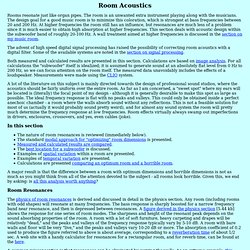
Given this, we end by asking: is all this analysis worth anything? The physics of room resonances is derived and discussed in detail in the physics section. '+picTitle+' CLICK TO CLOSE<\/title><\/head>') newWindow.document.write('<body background="'+picURL+'" onFocusOut="self.close()" onClick="self.close()" \/body><\/html>') newWindow.resizeBy(picWidth-newWindow.document.body.clientWidth, picHeight-newWindow. Performance below 100 Hz is what separates the men from the boys with acoustic treatment products.
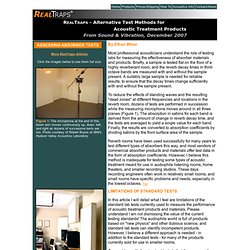
It's easy to build an absorber that works well at mid and high frequencies, and rigid fiberglass or acoustic foam one or two inches thick are common materials that do a fine job above 500 Hz. However, it's much more difficult to design an absorber that is highly effective below 100 Hz, yet these very low frequencies are usually the main problem in small or poorly proportioned rooms. With bass traps, performance below 100 Hz is what matters most! This reveals another limitation with the standard tests. Most US labs are not certified to measure below 100 Hz because they're not large enough to develop the reverberant field on which these tests rely. As a designer and manufacturer of bass traps and other acoustic treatment, I needed a more reliable way to assess low frequency absorbers and compare proposed trap designs. Acoustic Primer - Room Setup, Testing, Treatments. Fixing Room Acoustic Problems.
Another common acoustic problem with room is the amount of reverberation.
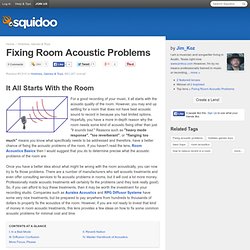
When a room is too reverberant, the recordings sound blurry and lack real detail. In addition, the coloring of the room dominants the sound and people will say things such as, “Sounds like you recorded this in your garage.” For the case of recording music using multiple microphones, the drier (i.e. less reverb) the room the better the recording will sound. If the room was going to be used for live performance, then a balance of reverb that is not too dry and not too reverberant is the goal.
University of Salford - A Greater Manchester University. Figure 1 Small sound reproduction rooms pose particular problems in acoustic design.
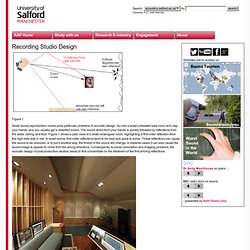
Go into a small untreated bare room and clap your hands, and you usually get a distorted sound. The sound direct from your hands is quickly followed by reflections from the walls, ceiling and floor. Figure 1 shows a plan view of a small rectangular room, highlighting a first order reflection from the right side wall in red. In small rooms, first order reflections tend to be loud and quick to arrive. Acoustics, Audio and Video.
These web pages gives some more detailed numerical results from an Audio Engineering Society journal paper which appeared in June 2004.
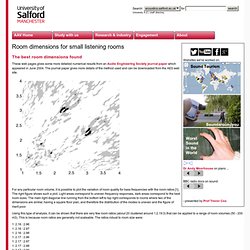
The journal paper gives more details of the method used and can be downloaded from the AES web site. For any particular room volume, it is possible to plot the variation of room quality for bass frequencies with the room ratios [1]. Α values. 0.00 = no absorbtion. 0.50 = 50% absorbtion. 1.00 = 100% absorbtion. Measurements are done according to a standard test method such as ASTM C423 or ISO. "In some cases, the measured sound absorption coefficient is greater than 1.00.
As recommended by the test method, these values are reported as measured and not adjusted. " "Differences in coefficients of less than 0.15 are not significant. " "The absorption coefficients that are typically published for acoustical materials are found using the reverberation chamber method. Owens Corning 700 series Rigid Fiberglass Owens Corning I'm unable to find Absorption Coefficient information on SOFTR Aeroflex Plus Acoustical Duct Liner (rolls, black on one side).
Owens Corning Fiberglass Batts (fluffy pink), on the wall, and 16" from the wall Roxul Rigid Rockwool. Modex Plate - LF Absorber. BBC: Modular Sound Absorber for LF. DIY Acoustic Panels video. GIK Acoustics: Room Setup. Real Traps: Acoustics Articles. Www.subwoofer-builder.com: QRD diffusers - Technical Overview. A QRD diffuser comprises wells of different depths, causing a mixture of phase shifts that diffuse reflected sound.

They are used to control reflections in the listening environment, particularly from rear walls and first-reflection points. Xenon's partially built N-23 diffusor Information on QRD diffusers is piecemeal and scattered across many sites and forums on the Internet, making it difficult for those who would like to know more about these devices. This page provides both a stand-alone overview of QRDs and a technical reference for the QRDude calculator.
Much of the information presented here is an interpretation of the following book: Acoustic Absorbers and Diffusers: Theory, Design and Application By Trevor Cox, Peter D'Antonio Google books has a partial display of the book, but for the full story, you will need to obtain your own copy This page aims to make a contribution by: